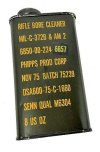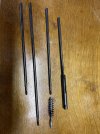Exactly. I've had a model 700 3006 for 30 years that I have never cleaned that ring out of. It's there but it shoots good so why mess with a good thing.Sell your borescope, problem gone! How were carbon rings cleaned before borescopes were imported?
You are using an out of date browser. It may not display this or other websites correctly.
You should upgrade or use an alternative browser.
You should upgrade or use an alternative browser.
A Million Dollar Opportunity!! Carbon Rings
- Thread starter Window
- Start date
 Help Support Long Range Hunting Forum
Help Support Long Range Hunting Forum
mine too.That was my thought too.
While I am not going to sell my borescope I do think that way too many words are being written about something that has an insignificant if any issue causing accuracy problems or any other problems for that matter. When I was shooting competitively in the Army we would sometimes shoot 1000 rounds a week between practices and matches. Barrels were cleaned on a regular basis with no borescope available to check the inside of the barrel to look at carbon rings or even copper or lead fouling. We used a product issued by the Army that was called RBC for short or it's actual name, "Rifle Bore Cleaner." It was manufactured to MIL-C-327B and AM 2. NSN: 6850-00-224-6657. I don't know what was in this stuff but it did wonders when used to clean a rifle barrel on anything from a M16 on up to a 255mm Howitzer. Get the barrel wet with it and go have a smoke (if you smoked) or a beer then come back, run a bore brush up and down the barrel 10 times then patches soaked in the stuff until they came out clean, usually 4 or 5 patches the run a few more dry ones and the bore came out spotless. Don't know if there was a carbon ring there or not, we didn't look for it. Keeping in mind that our M-14 match grade barrels were made by the lowest bidder when accuracy started to decline, usually between 5000 and 8000 rounds the issue was usually gas erosion not carbon rings, of course we didn't know that because throat condition was somewhat visible, but this mysterious carbon ring, if it was there had never been removed over the life of the barrel, unless RBC took care of that too. I see that it's available from Omaha Surplus. Maybe I will get some and see how it compares to the new supposedly miracle bore cleaners.Sell your borescope, problem gone! How were carbon rings cleaned before borescopes were imported?
Attachments
Yes Sir, I use those as well.I bought one of those cheap gun cleaning kits that cost like $20…it has a 4 piece, piece of crap rod, which is all I cared about.
I take the last piece and put it in a drill - the rod is maybe a foot long long or so. In that female end I put an oversized (one caliber larger) nylon brush and wrap a cleaning patch around it and put iosso on it, then run the drill bit for about 5-8 seconds and check the carbon ring with a bore scope. Repeat as needed, which for me is usually a few runs like that. It is really pretty easy.
Attachments
Those two are running H4831SC and H1000.What powder are you using in the rifle?
I wouldn't disagree with your statement at all. They are both good and bad. I do like the fact that they take the guess work out of it. These two rifles usually get 1000 to 1200 before they get new barrels and one thing I've found from using the bore scope and keeping the ring in check is consistency in velocity. Meaning whatever charge node it like from the beginning stays the same for the life of the barrel.Sell your borescope, problem gone! How were carbon rings cleaned before borescopes were imported?
I've never tried sea foam in a barrel but I'm definitely a fan of it in old engines. I'll give it a shot.I soak a bore mop in sea foam over night and it comes right out with a little brushing
Thanks
Are you talking about that awful smelling stuff that comes in the small, olive drab metal cans with the metal screw cap? I used to use that a lifetime ago, seemed to work good even when we shot the older corrosive ammunition.While I am not going to sell my borescope I do think that way too many words are being written about something that has an insignificant if any issue causing accuracy problems or any other problems for that matter. When I was shooting competitively in the Army we would sometimes shoot 1000 rounds a week between practices and matches. Barrels were cleaned on a regular basis with no borescope available to check the inside of the barrel to look at carbon rings or even copper or lead fouling. We used a product issued by the Army that was called RBC for short or it's actual name, "Rifle Bore Cleaner." It was manufactured to MIL-C-327B and AM 2. NSN: 6850-00-224-6657. I don't know what was in this stuff but it did wonders when used to clean a rifle barrel on anything from a M16 on up to a 255mm Howitzer. Get the barrel wet with it and go have a smoke (if you smoked) or a beer then come back, run a bore brush up and down the barrel 10 times then patches soaked in the stuff until they came out clean, usually 4 or 5 patches the run a few more dry ones and the bore came out spotless. Don't know if there was a carbon ring there or not, we didn't look for it. Keeping in mind that our M-14 match grade barrels were made by the lowest bidder when accuracy started to decline, usually between 5000 and 8000 rounds the issue was usually gas erosion not carbon rings, of course we didn't know that because throat condition was somewhat visible, but this mysterious carbon ring, if it was there had never been removed over the life of the barrel, unless RBC took care of that too. I see that it's available from Omaha Surplus. Maybe I will get some and see how it compares to the new supposedly miracle bore cleaners.
That would be very interesting to know. Do so and please share the results.While I am not going to sell my borescope I do think that way too many words are being written about something that has an insignificant if any issue causing accuracy problems or any other problems for that matter. When I was shooting competitively in the Army we would sometimes shoot 1000 rounds a week between practices and matches. Barrels were cleaned on a regular basis with no borescope available to check the inside of the barrel to look at carbon rings or even copper or lead fouling. We used a product issued by the Army that was called RBC for short or its actual name, "Rifle Bore Cleaner." It was manufactured to MIL-C-327B and AM 2. NSN: 6850-00-224-6657. I don't know what was in this stuff but it did wonders when used to clean a rifle barrel on anything from a M16 on up to a 255mm Howitzer. Get the barrel wet with it and go have a smoke (if you smoked) or a beer then come back, run a bore brush up and down the barrel 10 times then patches soaked in the stuff until they came out clean, usually 4 or 5 patches the run a few more dry ones and the bore came out spotless. Don't know if there was a carbon ring there or not, we didn't look for it. Keeping in mind that our M-14 match grade barrels were made by the lowest bidder when accuracy started to decline, usually between 5000 and 8000 rounds the issue was usually gas erosion not carbon rings, of course we didn't know that because throat condition was somewhat visible, but this mysterious carbon ring, if it was there had never been removed over the life of the barrel, unless RBC took care of that too. I see that it's available from Omaha Surplus. Maybe I will get some and see how it compares to the new supposedly miracle bore cleaners.
tuscan
Well-Known Member
- Joined
- May 24, 2015
- Messages
- 147
We've used advances in machining capabilities to tune our custom rifles to extremely tight tolerances. In so doing, we've gotten very precise weapons. But, in that system carbon rings can create loss of precision and or consistency that wouldn't have been noticeable in older factory rifles. Rings can also create overpressure. So, I don't worry about rings in my savage or Winchester or even my hunting only rifles. Normal cleaning is enough. But my competition rifles need a little more TLC/C4.I wouldn't disagree with your statement at all. They are both good and bad. I do like the fact that they take the guess work out of it. These two rifles usually get 1000 to 1200 before they get new barrels and one thing I've found from using the bore scope and keeping the ring in check is consistency in velocity. Meaning whatever charge node it like from the beginning stays the same for the life of the barrel.
best defense
Well-Known Member
I don't know if you've tried it or not, but "Bore Tech" has a product specifically designed to remove carbon. I have found that it works well for me. Filtz is kind of harsh as a cleaning agent. It is designed to be a polishing agent and may have a negative effect on the lands in your rifle if you use it frequently.I've spent all weekend getting carbon rings out of two rifles that had less than 50 rounds ran through them since the last carbon ring removal. One has 460 rounds through it and the other has 290. Can someone/anyone come up with a simple way to make this easy? I know that there are many of you who are 10X smarter than I am although I've been at this for over thirty years. I've gone through hundreds of patch of Bore Tech, used Iosso, CLR and finally made progress with Flitz. There has to be a better way! Here's the a before and after of the one with 460 rounds total and less than 50 rounds since its last carbon ring removal. Please note that it's 30-378 that's never been pushed hard. Any good advice from the great mins out there?
Did the rifle shoot bad ?I've spent all weekend getting carbon rings out of two rifles that had less than 50 rounds ran through them since the last carbon ring removal. One has 460 rounds through it and the other has 290. Can someone/anyone come up with a simple way to make this easy? I know that there are many of you who are 10X smarter than I am although I've been at this for over thirty years. I've gone through hundreds of patch of Bore Tech, used Iosso, CLR and finally made progress with Flitz. There has to be a better way! Here's the a before and after of the one with 460 rounds total and less than 50 rounds since its last carbon ring removal. Please note that it's 30-378 that's never been pushed hard. Any good advice from the great mins out there?

